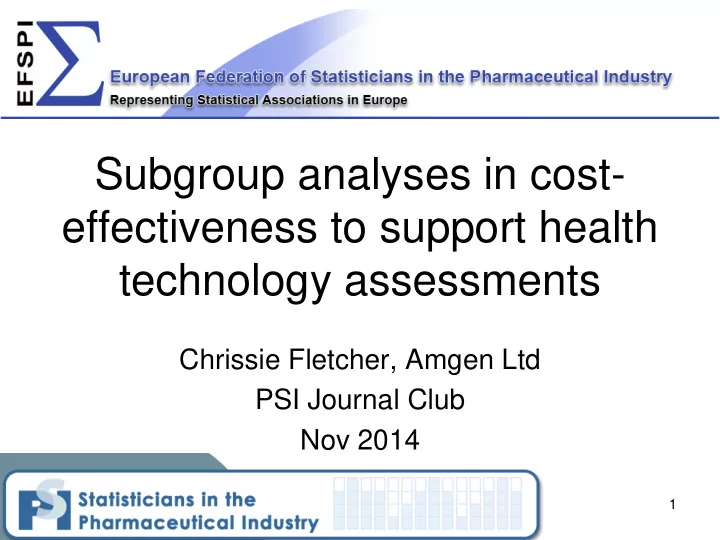

Subgroup analyses in cost- effectiveness to support health technology assessments Chrissie Fletcher, Amgen Ltd PSI Journal Club Nov 2014 1
Acknowledgements 2
Disclaimer • The views expressed herein represent those of the presenter and do not necessarily represent the views or practices of Amgen. 3
Overview • Introduction • Statistical considerations in cost- effectiveness analyses • Guiding principles for subgroups in cost- effectiveness • Example case study • Discussion and conclusions 4
Introduction • “Health technology assessment (HTA) is a form of policy research that examines the short-term and long-term social consequences (e.g. societal, clinical, economic, ethical and legal) of the application of technology” (Banta D) • Cost-effectiveness analysis (CEA) seeks to identify technologies that if funded, maximise total population health 5
Introduction (cont) • Subgroup analyses in CEA help to understand key drivers of CE, quantify the uncertainty and extent of heterogeneity • Many national pharmacoeconomic guidance's provide recommendations on how to assess patient heterogeneity but there is no consensus on which specific methods are most appropriate 6
Introduction (cont) 7 7
Principles and best practices for subgroup analyses (Paget et al) Subgroups pre-specification & definition Subgroup by treatment interaction Multiplicity issues Sensitivity analyses Replication Source of evidence Presenting and reporting subgroup results 8
Statistical considerations in CEA Random variation? Uncertainty ? Generalisability ? CEA in Overall subgroups CEA Subgroup definition ? Number of subgroups ? Cost to identify subgroup ? 9
When is a subgroup cost- effective? 10
Subgroup effects can be predictive or prognostic Prognostic subgroup Predictive subgroup New treatment New treatment Response Response Standard of care Standard of care A B A B Subgroup Subgroup No subgroup effect Concluding a subgroup is predictive can depend Response New treatment on the scale used to Standard of care measure the treatment effect A B 11 Subgroup
Subgroups for regulatory vs reimbursement Regulatory Reimbursement • Assess consistency of • Assess total budget treatment effects in impact of multiple individual subgroup subgroup factors factors considered jointly (optimise healthcare • Balance of benefit and spend under constraints) risks • Balance benefit, risks and costs Both concerned with ‘optimism’ bias, biological plausibility, credibility, and relevance to clinical practice 12
Planning subgroups in confirmatory trials • Consider for both regulators and payers • Regulatory (EMA draft guideline) – Assessing consistency, biological plausibility, replication, pre-specification and multiplicity • Payers (EUnetHTA, NICE methods) – Absolute effects (scale), biological and economic plausibility, pre-specification, quantify heterogeneity (estimation) 13
Useful approaches in subgroup analyses for CEA • Bayesian analysis to shrink subgroup results towards average population • Probabilistic sensitivity analyses (PSA) Rejection Costs threshold Zone of uncertainty Dominated Acceptance threshold QALY Dominant 14
Guiding principles for cost- effectiveness subgroup analyses Clinical effectiveness Cost-effectiveness Sensitivity analyses Extremely important Presenting and reporting Transparency Replication Important Source of evidence All data sources Pre-specification of Desirable subgroups Multiplicity issues Less important Subgroup by trt 15 interaction 15
Example case study 16 16
Discussions and conclusions • Subgroup analyses are important in CEA • Many subgroup analyses guiding principles for clinical effectiveness apply to CEA • Importance of documenting methods, assumptions and sensitivity analyses • Statisticians and health economics together should plan analytical strategies for CEA early in the drug development process 17
Subgroup analyses in support cost-effectiveness to support health technology assessments Chrissie Fletcher, Amgen Ltd PSI Journal Club Nov 2014
Recommend
More recommend